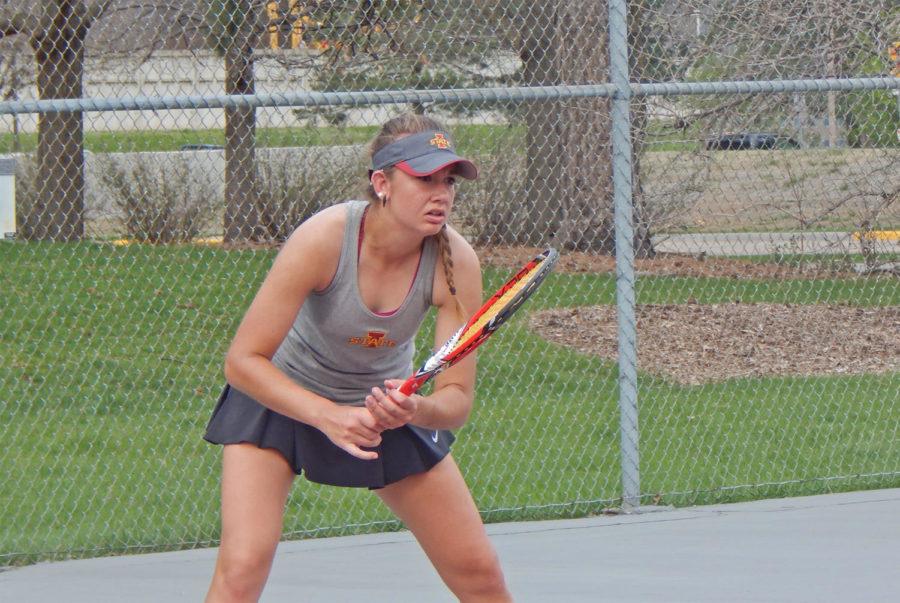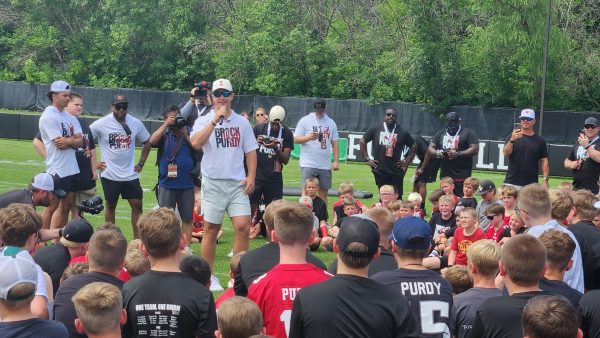A majority of minorities: ISU tennis team capitalizes on international recruiting market
Dalton Gackle/Iowa State Daily
Junior Ana Gasparovic awaits a serve during her singles match against No. 10 Oklahoma State. Oklahoma State defeated Iowa State 4-0.
October 15, 2015
Iowa State is well known for its international student enrollment. This year, 4,091 international students enrolled, accounting for 11 percent of the student body.
The ISU tennis team is an anomaly when compared with this statistic.
The Cyclones are comprised of 60 percent international students after adding three this season. This has been a common trend for the team, which has been heavily recruiting international prospects for a number of years.
“It’s very difficult for us to recruit American players to Iowa State because we don’t have the traditions that other major programs have,” said ISU tennis coach Armando Espinosa.
This doesn’t mean Iowa State hasn’t tried to compete in the domestic recruiting market. The Cyclones signed their first pair of national players since 2010 with the additions of Liera Bender and Claudia Toledo for the 2014-15 season.
The Cyclones began searching internationally so they could locate the talent to compete with major Big 12 teams. Since opposing teams began gathering top classes littered with blue chips, The Cyclones had to adopt a new strategy.
This meant that Espinosa had to start examining the vast pool of international talent. He believes it’s possible to find talent abroad to compete with the top tier of American players because of the increased depth.
Iowa State has a unique advantage because it can offer competition against top-tier opponents and a great education. These two are generally mutually exclusive abroad, but players are able to pursue both in the United States.
“For most international players, you either go play professionally or you get an education because most universities don’t have sports programs or scholarships,” said Ana Gasparovic, senior from Zagreb, Croatia.
Once the players decide on Iowa State, they bring a variety of playing styles and world views to the team. This infusion of different styles and ideas has a tremendous impact on the Cyclones, whether they are on or off the court.
“I love playing with all the different cultures,” said Natalie Phippen, the longest tenured domestic player on the team. “Growing up in America, we all kind of think one way. I think it’s really fun to see how they grew up and how they came to play tennis.”
The international players all tend to bring a different style of play. Over time, Espinosa has noticed slight differences, such as the energy Central and South American players play with, or the aggressive precision of European prospects.
These differences help the Cyclones by providing a variety of challenges to opposing teams, but the styles don’t necessarily translate from player to player.
“We can’t have our smaller players try to play with the power of the taller ones because it won’t have the same effect in a match, so we want them to stick with what they do best and then improve from there,” Espinosa said.
Regardless of style, international players and ISU tennis share a symbiotic relationship. Iowa State gives international players multiple opportunities to learn and compete at a high level, which are almost nonexistent outside the United States. International players, in turn, have become the driving force behind ISU tennis.

















